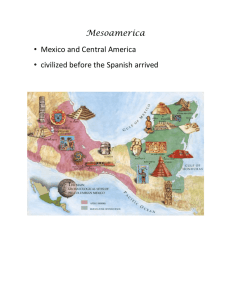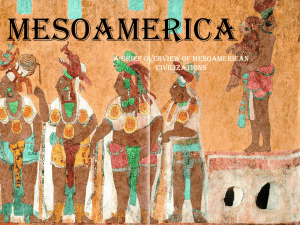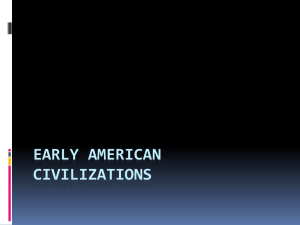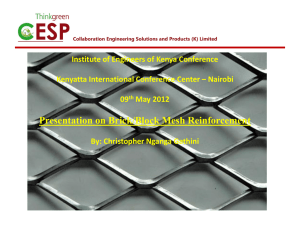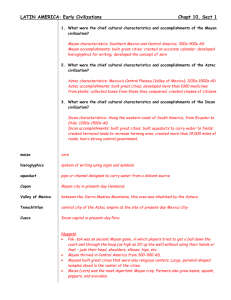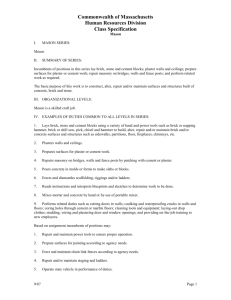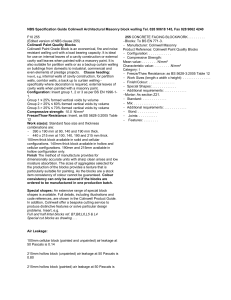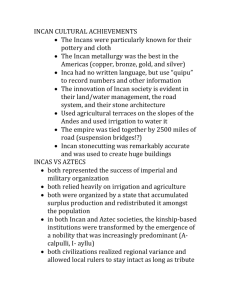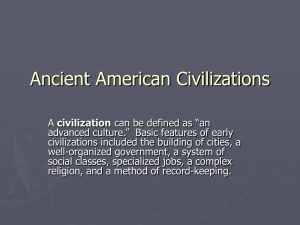PRECOLOMBIAN ART II
advertisement
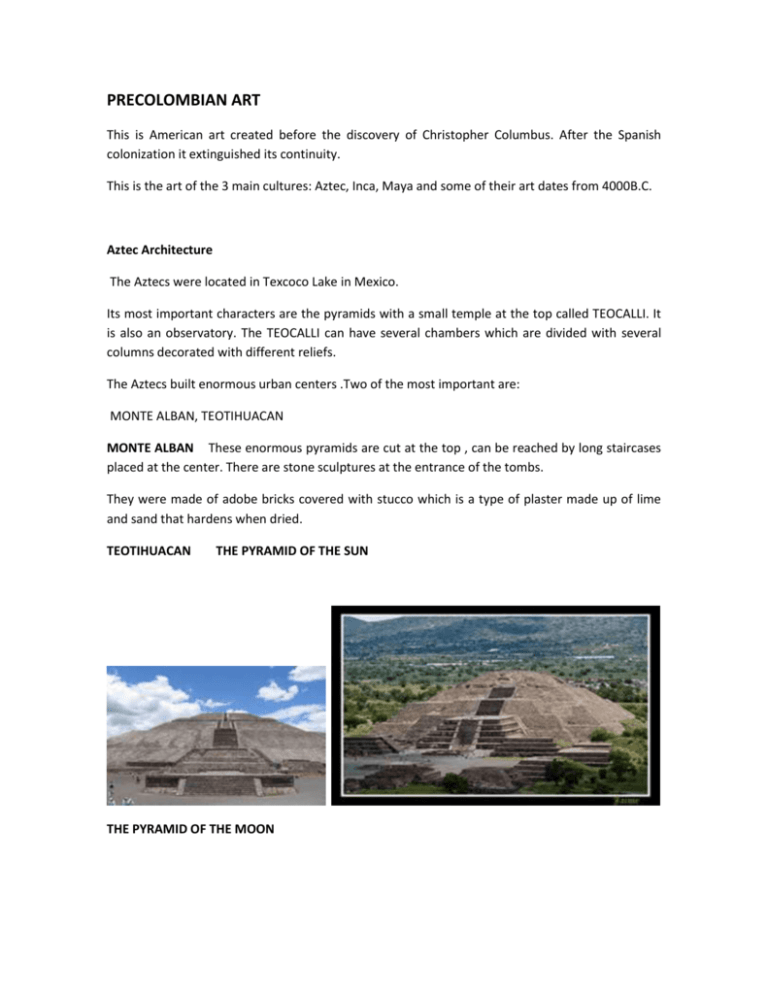
PRECOLOMBIAN ART This is American art created before the discovery of Christopher Columbus. After the Spanish colonization it extinguished its continuity. This is the art of the 3 main cultures: Aztec, Inca, Maya and some of their art dates from 4000B.C. Aztec Architecture The Aztecs were located in Texcoco Lake in Mexico. Its most important characters are the pyramids with a small temple at the top called TEOCALLI. It is also an observatory. The TEOCALLI can have several chambers which are divided with several columns decorated with different reliefs. The Aztecs built enormous urban centers .Two of the most important are: MONTE ALBAN, TEOTIHUACAN MONTE ALBAN These enormous pyramids are cut at the top , can be reached by long staircases placed at the center. There are stone sculptures at the entrance of the tombs. They were made of adobe bricks covered with stucco which is a type of plaster made up of lime and sand that hardens when dried. TEOTIHUACAN THE PYRAMID OF THE SUN THE PYRAMID OF THE MOON AZTEC PAINTINGS The themes of these paintings were religious showing worship, power and sometimes they were very cruel because they showed human sacrifices. Balance and proportion were used in their paintings so as a focal point. Their figures are mostly based on geometric figures with lots of decorations around. The colors used were vivid and mostly plain. Most of the time animals are portrayed and in some others humans with heads of animals. Several murals have been found. AZTEC SCULPTURE It is closely related to architecture since it was carved on the architectural structures or added to the walls. Its main characteristics are: Cubist tendency Search for realism Imitation of nature Fantasy in surprising combinations Like the other pre-Columbian arts Aztec art represents their religion. The cruelty of it is shown in some of their sculptures .The end of their art is not to decorate but to pay tribute to their religion. Much of their art is done in relief painted in several colors INCAN ARCHITECTURE SEDIMENTARY MASONRY Encased Masonry CELLULAR POLYGONAL MASONRY CYCLOPEAN MASONRY One of the most fascinating characteristics of Incan Architecture is the facts that in some structures the stones were cut with certain precision that they would fit perfectly to the others around and no mortar was used .Most of the time the stones of a structure were of different size and shape. Adobe walls were also quite common, usually laid over stone foundations. The material used in Inca buildings depended on the region, in the coast they used large rectangular adobe blocks while in the Andes they used local stones. The most common shape in Incan architecture was the rectangular building without any internal walls and roofed with wooden beams and thatch. Wall apertures, including doors, niches and windows, usually had a trapezoidal shape. Monolithic dentils were used a lot. The most common composite form in Inca architecture was the kancha, a rectangular enclosure housing three or more rectangular buildings placed symmetrically around a central courtyard. .Several kancha could be grouped together to form blocks in Inca settlements. These were the different types of masonry: • Encased coursed masonry: in which stone blocks are not aligned • Sedimentary coursed masonry: in which stones are laid out in horizontal rows (i.e., ashlars) • Cellular polygonal masonry: with small blocks • Cyclopean polygonal masonry: with very large stones Usually the walls of Incan buildings were slightly inclined inside and the corners were rounded. This was very efficient since the buildings were safe during earthquakes or movements. INCAN SCULPTURES These were done in different types of materials: clay, stone, gold and silver. Most were melted by the Spaniards during the conquest of the Spaniards. These are geometric with not much realism since bodies have no proportion and not very esthetic. Mayan ART This civilization settled in 4 countries: Mexico,Guatemala,El Salvador and Honduras. Like the other civilizations mentioned the Mayan art was for worshipping their gods and kings. All of their art was narrating about their governers, their history, and customs through an impressive imagination. Architecture They made temples and palaces. Poor people lived in wooden houses with palm roofs. Atahe palaces were made over low bases and had several chambers while the temples were built on top of pyramids. On top of the pyramids they built temples and some had several chambers. Mayans used mortar made out of lime, sand and water. Their walls were thick and had just a few windows but some structures were made without mortar. The façade was decorated friezes and the false vault was very popular. The Acropolis is in the heart of Copan. Here were the architectural structure of the kings. It is made of two plazas; the eastern and western. Both are enclosed by two elevated structures. Long tunnels were excavated under the Acropolis revealing the architectural advances they had. These tunnels also had glyphics that tell about the first governers. The most outstanding architectural structures would be the pyramid at Tikal, Guatemala, the ballcourt of Copan,the Ruins of Calakmul, ChichenItza in Mexico. The staircase of the hieroglyphics; AD 800 Narrates the reign of 16 governers OF Copan Considered the social center of the city. This park is by far the most artistic ball court in Meso-America. Unique to it are the markers on the side walls, resembling macaw heads. The final work done on this ball court goes back to the days of ruler 18 Rabbit between AD 711-736 Sculpture It is closely associated with architecture and there is a religious influence. The main figures in Mayan sculptures were geometric. Most were made in stone and some in wood. Jade and obsidian have been found. Many stucco sculptures have been found in the façade of buildings. The most famous are the stellas found in Copan. These monumental structures were covered with reliefs of hieroglyphics and decorations. They represented their kings and were done at the end of each period. Through out the hieroglyphics important acts of their reign were narrated. CERAMICS Their ceramic was polychromated related to funerary events. Inscineraries, jars of medicines, for essences, urns. Some figures were made with molds while other by hand. Some ceramic pieces were destroyed in ceremonies representing that they were releasing what they were carrying. Many were used for sacrificial ceremonies. Ceramics were impressive since they were done very well with out having any special instruments. Palenque Mayan Ruins in Chiapas Mexico Bonampak Ruins – On top there is a room holding the beautiful Mayan murals. Murals of Bonampak Murals in three separate chambers.. The well preserved murals cover the walls and ceilings and are believed to have been painted around 800 AD, near the height of Maya civilization. They depict in great detail the rituals of the royal court including human sacrifice, costumes, musical instruments, and the weapons of war. Realism, perspective, vivid colors and good sense of proportion.


